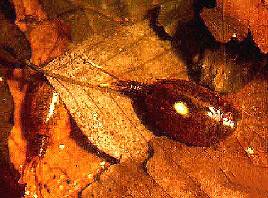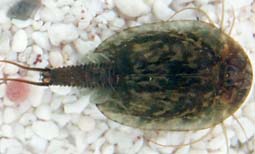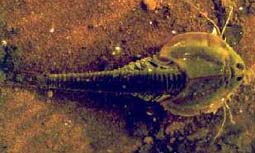Species Descriptions
by Chip Hannum (upd: Stuart Halliday).
Below are tables describing briefly what I know about the 15 major species. Do not take my range descriptions as gospel; no mention does not mean a species is not present somewhere and a mention is hardly a guarantee. Available information is sometimes sketchy and I’ve noted more questionable points with a question mark.
Lepidurus apus
| Major species | Lepidurus apus |
| Subspecies | Lepidurus apus apus, L. apus lubbocki, L. apus patagonicus, L. apus viridis |
| Range | Africa (North), Asia, Australia (viridis only), Europe (Austria, Bosnia, Croatia, Czech Republic, Denmark, France, Germany, Herzegovina, Hungaria, Italy, Macedonia, Morocco, Scandinavia, Slovakia, Spain, Yugoslavia), Israel, New Zealand, South America (?) |
| Habitat | Temporary but often longer lasting freshwater pools |
| Reproduction | Bisexual, Hermaphroditic |

L. apus has one of the greatest ranges of any of the triops being found throughout continental Europe, Northern Africa, and one of only two notostracans found in Australia. Life cycle is typical of the lepidurans with a significant percentage of laid eggs hatching after a few weeks in the water.
One of the more controversal of the species as Longhurst originally lumped L. couesii and L. packardii into the species in spite of distinct characters that argued otherwise.
Longhurst mentions a South American subspecies L. apus patagonicus but I have found no reference to this triops anywhere outside of his paper.
Lepidurus arcticus
| Major species | Lepidurus arcticus |
| Range | Asia (Northern): Kuril Archipelago, Russia; Europe (Northern): Norway, Greenland, Svalbard |
| Habitat | Cold temporary freshwater pools but is also found in streams and lakes where conditions allow |
| Temperature range | Minimum 4-7°C |
| Reproduction | Bisexual (female biased) and hermaphroditic |
L. arcticus is one of the most unique of the triops. Not only does it inhabit permanent fresh bodies of water, it is even known to coexist with arctic charr in some deep Norwegian, Greenland and Svalbard lakes. As a rule, though, it lives in high arctic lakes shallower than 6 meters - the lakes freeze completely during the colder seasons and this keeps fish from living there. Scientists are actively studying the trophic relation between L. arcticus and the arctic charr in those lakes they coexist in to understand the delicate ecology better.
Triops australiensis
| Major species | Triops australiensis |
| Subspecies | T. australiensis australiensis, T. australiensis sakalavus |
| Range | Australia, Madagascar, New Caledonia |
| Habitat | Temporary freshwater pools |
| Reproduction | Hermaphroditic |
T. australiensis is the Australian triops. It is unique among triops species in having a haploid chromosome number of n = 5 versus the n = 4 of other Triops species.
Triops cancriformis
| Major species | Triops cancriformis |
| Subspecies | T. cancriformis cancriformis, T. cancriformis mauretanicus, T. cancriformis simplex |
| Range | Africa (North), Asia, Europe (widespread), Japan |
| Habitat | Temporary freshwater pools |
| Temperature range | 15-34°C (optimal 22-25°C) |
| Reproduction | Bisexual (female biased), Hermaphroditic |

T. cancriformis is the oldest known living animal species with fossils dating back 200 million years to the Upper Triassic age. It is one of the most well-studied triops species and is commonly available in Europe. This species can grow up to 11 cm in length in the wild, though 6-8 cm is more typical in captivity.
Triops granarius
| Major species | Triops granarius |
| Range | Africa (Kenya, Zimbabwe), Middle East |
| Habitat | Temporary freshwater pools, rice paddies |
| Reproduction | Obligately bisexual (male biased populations common) |
T. granarius is notable for being one of the few obligately sexually reproducing triops species. It has been studied extensively in Africa as a potential food source, though its cannibalistic tendencies under high population density make it unsuitable for aquaculture.
Triops longicaudatus
| Major species | Triops longicaudatus |
| Subspecies | T. longicaudatus longicaudatus, T. longicaudatus intermedius |
| Range | North America (western US, southwestern US), Central America, South America, Galapagos Islands, Japan, New Caledonia, Caribbean |
| Habitat | Temporary freshwater pools, desert potholes, rice paddies |
| Temperature range | 16-35°C (optimal 22-27°C) |
| Reproduction | All forms: Bisexual, Unisexual, Hermaphroditic |

T. longicaudatus is the American triops and one of the most widespread triops species, found across multiple continents. It is commonly available in triops kits sold in the United States. This species exhibits all major reproductive strategies among its geographically isolated populations and grows to 4-6 cm in captivity. Genetic analysis has revealed at least five distinct subspecies that are currently all classified as T. longicaudatus.
Triops newberryi
| Major species | Triops newberryi |
| Range | Western United States (California, Nevada, Oregon) |
| Habitat | Desert and montane temporary pools |
| Reproduction | Hermaphroditic |
T. newberryi is found in the western United States and shares habitat with T. longicaudatus in some areas. Like T. longicaudatus, genetic analysis has revealed multiple cryptic subspecies within this classification.
Triops numidicus
| Major species | Triops numidicus |
| Range | North Africa (Algeria, Morocco, Tunisia) |
| Habitat | Temporary freshwater pools |
T. numidicus is a North African species that is poorly studied. Its status as a separate species versus a subspecies of T. cancriformis has been debated, with some scientists considering Longhurst’s classification outdated.
This section is incomplete and contributions from triops researchers would be greatly appreciated. Additional species including various Lepidurus species (L. batesoni, L. bilobatus, L. couesii, L. cryptus, L. lemmoni, L. lynchi, L. mongolicus, L. packardii) exist but detailed information is limited.
